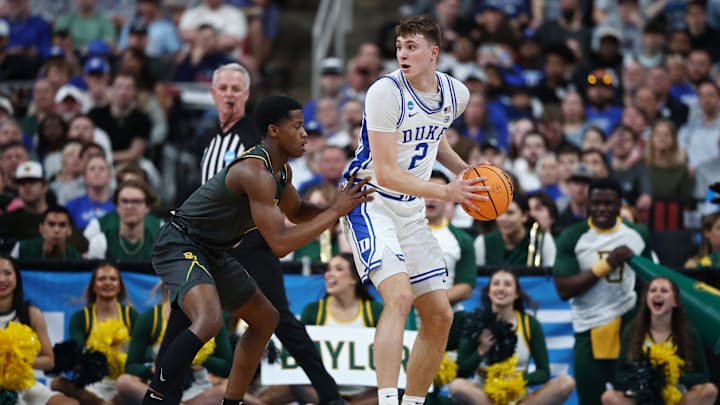When the Utah Jazz finished the 2024-25 regular season with the worst record in the NBA, a consolation prize immediately softened the blow. By finishing with one of the three lowest winning percentages in the Association, Utah gained a share of the best odds to land the No. 1 pick—and thus, add generational prospect Cooper Flagg.
For as compelling as that possibility remains, there's an 86.0 percent chance that Utah won't secure the No. 1 pick—a reality that would force it to reevaluate its options leading up to the draft.
Thankfully, Flagg isn't the only high-level prospect worth investing in at the 2025 NBA Draft. The top-end talent is deeper than it was a year ago, and the Jazz will thus have an opportunity to make a splash regardless of where they fall in the draft order.
Guaranteed to pick no lower than No. 4 overall, Utah will have multiple opportunities to select players with All-NBA, as well as All-Defense, potential.
At the top of that list are three prospects who not only have otherworldly potential, but fit Utah's current hierarchy. No one in Utah should be labeled untouchable, but giving a new franchise player ideal assets to work with is worth considering.
Thankfully, three non-Flagg prospects project to be able to elevate the Jazz over the course of what should pan out as memorable careers.
3. Ace Bailey, Wing, Rutgers Scarlet Knights
The No. 3 spot was difficult to assign, as it came down to two high-upside scorers: Ace Bailey and Tre Johnson. Bailey is a 6'10" dynamic scoring threat with absurd potential, while Johnson is a more refined shot-maker who shakes off contact and finds the bottom of the net in almost any scenario at 6'6".
Johnson could emerge as the more logical pick as soon as next month, but for now, he's an honorable mention while Bailey's limitless potential takes the No. 3 spot.
Bailey is a 6'10" offensive dynamo who has the sincere upside to become a 25-a-night level scorer in the NBA. He shoots over defenders with relative ease, and is too quick for traditional bigs to defend him on their own out in space.
If Bailey fills out his frame in the way he should be able to, then he'll also be too strong for the average wing to guard—thus making him the ultimate matchup nightmare.
For Utah, adding Bailey would mean making a clear declaration about their scoring hierarchy centering around a clear No. 1—a necessary change. It would also enable the team to ease Bailey into replacing Lauri Markkanen, to whom he compares favorably but as a younger and more malleable talent.
Johnson will need serious consideration here, but Bailey's untapped potential is that of an All-NBA talent who can compete for scoring titles—ambitious as that may sound.
2. V.J. Edgecombe, Wing, Baylor Bears
Teams can't win in the modern NBA without having wings they can depend on for two-way contributions. It's a simple fact that should comfortably lead Utah to considering V.J. Edgecombe with anything other than the No. 1 overall selection.
The Baylor Bears star is a prototypical wing for the modern NBA, combining ideal size with remarkable athleticism, elite defensive potential, an already respectable shot, and actual signs of offensive upside.
Edgecombe isn't the latest in a long line of players whom teams are hoping they can mold into the next Kawhi Leonard. He's already proven capable of playing with the ball in his hands, creating for both himself and others at commendable levels.
Those aren't star-caliber strengths at the NBA level quite yet, but he averaged 3.2 assists on a team with multiple ball-handlers and has a more advanced bag than your typical upside player.
Edgecombe also shot 36.7 percent from beyond the arc and 80.7 percent at the free throw line over his past 25 games. That at least suggests there's sincere 3-and-D potential for a player whose athleticism and defensive tenacity have him rising up draft boards.
There's untapped potential, which has its pros and cons, but Edgecombe has already shown enough to warrant Utah's potential interest with a top-four pick.
1. Dylan Harper, Lead Guard, Rutgers Scarlet Knights
Widely regarded as the No. 2 prospect in the 2025 NBA Draft, Dylan Harper is following in his father Ron Harper's footsteps in a myriad of ways. Not only is he set to join his father as a top-10 draft pick, but much like the elder Harper, the Rutgers Scarlet Knights star is a big guard with a versatile skill set.
Standing at 6'6" and 215 pounds, Harper is a lead guard with the ability to attack off the bounce, shoot with signs of potential efficiency, finish creatively, and run an explosive offense.
Harper finished his freshman season with averages of 19.4 points, 4.6 rebounds, 4.0 assists, 1.4 steals, 0.6 blocks, and 1.7 three-point field goals made per game. Beyond the numbers, he's a dynamic shot creator who will tower over the average NBA point guard and already seems to know how to use his size to his advantage.
When all else fails, Harper is as skilled as any player in this class with the ball in his hands, possessing the ability to create space or attack downhill with a deep bag of tricks and below-the-rim proficiency.
It's also worth noting that Harper, while not a great shooter, is nowhere near the level of a full-on project. He shot 75.0 percent at the free throw line and 33.3 percent from beyond the arc, and his form supports improved efficiency in both areas as his shot selection improves.
A creative dynamo with elite size and downhill capabilities, Harper is the franchise point guard the Jazz have been dreaming of.
